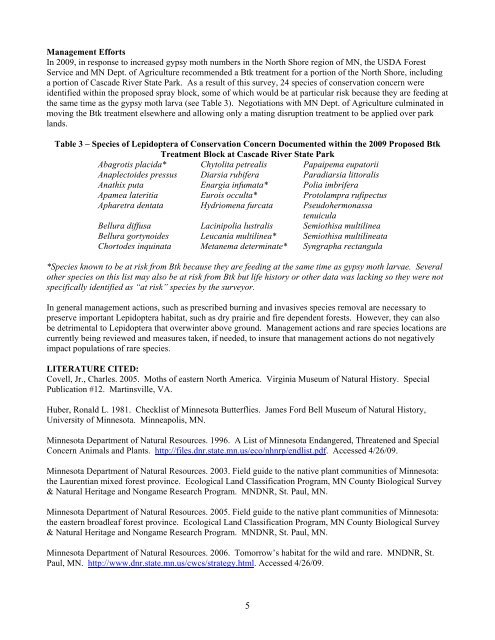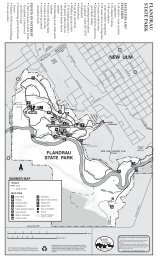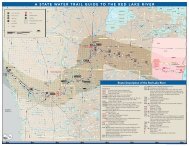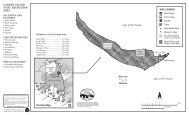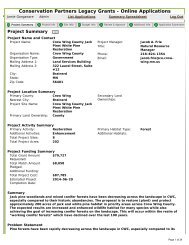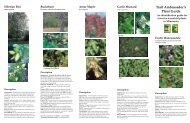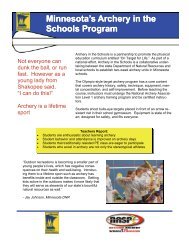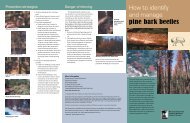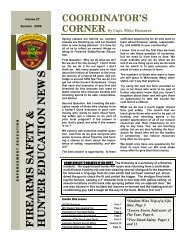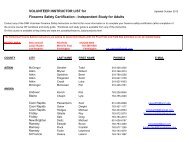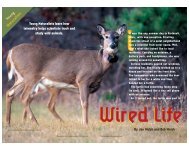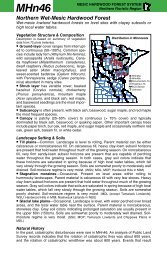A survey of Lepidoptera in three priority areas of the Minnesota state ...
A survey of Lepidoptera in three priority areas of the Minnesota state ...
A survey of Lepidoptera in three priority areas of the Minnesota state ...
You also want an ePaper? Increase the reach of your titles
YUMPU automatically turns print PDFs into web optimized ePapers that Google loves.
Management Efforts<br />
In 2009, <strong>in</strong> response to <strong>in</strong>creased gypsy moth numbers <strong>in</strong> <strong>the</strong> North Shore region <strong>of</strong> MN, <strong>the</strong> USDA Forest<br />
Service and MN Dept. <strong>of</strong> Agriculture recommended a Btk treatment for a portion <strong>of</strong> <strong>the</strong> North Shore, <strong>in</strong>clud<strong>in</strong>g<br />
a portion <strong>of</strong> Cascade River State Park. As a result <strong>of</strong> this <strong>survey</strong>, 24 species <strong>of</strong> conservation concern were<br />
identified with<strong>in</strong> <strong>the</strong> proposed spray block, some <strong>of</strong> which would be at particular risk because <strong>the</strong>y are feed<strong>in</strong>g at<br />
<strong>the</strong> same time as <strong>the</strong> gypsy moth larva (see Table 3). Negotiations with MN Dept. <strong>of</strong> Agriculture culm<strong>in</strong>ated <strong>in</strong><br />
mov<strong>in</strong>g <strong>the</strong> Btk treatment elsewhere and allow<strong>in</strong>g only a mat<strong>in</strong>g disruption treatment to be applied over park<br />
lands.<br />
Table 3 – Species <strong>of</strong> <strong>Lepidoptera</strong> <strong>of</strong> Conservation Concern Documented with<strong>in</strong> <strong>the</strong> 2009 Proposed Btk<br />
Treatment Block at Cascade River State Park<br />
Abagrotis placida* Chytolita petrealis Papaipema eupatorii<br />
Anaplectoides pressus Diarsia rubifera Paradiarsia littoralis<br />
Anathix puta Enargia <strong>in</strong>fumata* Polia imbrifera<br />
Apamea lateritia Eurois occulta* Protolampra rufipectus<br />
Apharetra dentata Hydriomena furcata Pseudohermonassa<br />
tenuicula<br />
Bellura diffusa Lac<strong>in</strong>ipolia lustralis Semiothisa multil<strong>in</strong>ea<br />
Bellura gortynoides Leucania multil<strong>in</strong>ea* Semiothisa multil<strong>in</strong>eata<br />
Chortodes <strong>in</strong>qu<strong>in</strong>ata Metanema determ<strong>in</strong>ate* Syngrapha rectangula<br />
*Species known to be at risk from Btk because <strong>the</strong>y are feed<strong>in</strong>g at <strong>the</strong> same time as gypsy moth larvae. Several<br />
o<strong>the</strong>r species on this list may also be at risk from Btk but life history or o<strong>the</strong>r data was lack<strong>in</strong>g so <strong>the</strong>y were not<br />
specifically identified as “at risk” species by <strong>the</strong> <strong>survey</strong>or.<br />
In general management actions, such as prescribed burn<strong>in</strong>g and <strong>in</strong>vasives species removal are necessary to<br />
preserve important <strong>Lepidoptera</strong> habitat, such as dry prairie and fire dependent forests. However, <strong>the</strong>y can also<br />
be detrimental to <strong>Lepidoptera</strong> that overw<strong>in</strong>ter above ground. Management actions and rare species locations are<br />
currently be<strong>in</strong>g reviewed and measures taken, if needed, to <strong>in</strong>sure that management actions do not negatively<br />
impact populations <strong>of</strong> rare species.<br />
LITERATURE CITED:<br />
Covell, Jr., Charles. 2005. Moths <strong>of</strong> eastern North America. Virg<strong>in</strong>ia Museum <strong>of</strong> Natural History. Special<br />
Publication #12. Mart<strong>in</strong>sville, VA.<br />
Huber, Ronald L. 1981. Checklist <strong>of</strong> M<strong>in</strong>nesota Butterflies. James Ford Bell Museum <strong>of</strong> Natural History,<br />
University <strong>of</strong> M<strong>in</strong>nesota. M<strong>in</strong>neapolis, MN.<br />
M<strong>in</strong>nesota Department <strong>of</strong> Natural Resources. 1996. A List <strong>of</strong> M<strong>in</strong>nesota Endangered, Threatened and Special<br />
Concern Animals and Plants. http://files.dnr.<strong>state</strong>.mn.us/eco/nhnrp/endlist.pdf. Accessed 4/26/09.<br />
M<strong>in</strong>nesota Department <strong>of</strong> Natural Resources. 2003. Field guide to <strong>the</strong> native plant communities <strong>of</strong> M<strong>in</strong>nesota:<br />
<strong>the</strong> Laurentian mixed forest prov<strong>in</strong>ce. Ecological Land Classification Program, MN County Biological Survey<br />
& Natural Heritage and Nongame Research Program. MNDNR, St. Paul, MN.<br />
M<strong>in</strong>nesota Department <strong>of</strong> Natural Resources. 2005. Field guide to <strong>the</strong> native plant communities <strong>of</strong> M<strong>in</strong>nesota:<br />
<strong>the</strong> eastern broadleaf forest prov<strong>in</strong>ce. Ecological Land Classification Program, MN County Biological Survey<br />
& Natural Heritage and Nongame Research Program. MNDNR, St. Paul, MN.<br />
M<strong>in</strong>nesota Department <strong>of</strong> Natural Resources. 2006. Tomorrow’s habitat for <strong>the</strong> wild and rare. MNDNR, St.<br />
Paul, MN. http://www.dnr.<strong>state</strong>.mn.us/cwcs/strategy.html. Accessed 4/26/09.<br />
5


